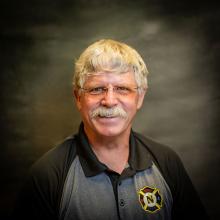Faculty

Staff



Fire Science Technology is the study of:
The specialized knowledge gained through an education in fire science equips first responders with; the skills and mental tools to effectively save lives and protect property and the environment. Careers in emergency services require courage, endurance, integrity and the ability to make good and quick decisions in emergencies. Teamwork is necessary to safely solve an emergency situation. The qualities of hard work and self-discipline must be quickly mastered through both online and traditional learning opportunities. You will take these characteristics from the classroom to the fire station and throughout your life.
You may find through your training experience that you have a desire to follow other career paths within the emergency services profession. Some of the exciting careers include:
In order to provide the best services and marketability, it is our desire to graduate students with the following state certifications:
Essential Functions:
Choose one of the following courses:
| Course Number | Course Title | Credits | Details |
|---|---|---|---|
ENG115ENG1015 |
Technical English & Communication | 3 | |
|
Focuses on the written and oral communication needs of students in vocational and technical fields. Enables the student to practice written, oral, reading, reasoning, and interpersonal communication skills in order to become successful (or to remain successful) in the workplace. (3-0) |
|||
ENG121ENG1021 |
English Composition I: GT-CO1 | 3 | |
|
Emphasizes the planning, writing, and revising of compositions, including the development of critical and logical thinking skills. This course includes a wide variety of compositions that stress analytical, evaluative, and persuasive/argumentative writing. This is a statewide Guaranteed Transfer course in the GT-CO1 category. Prerequisite: College Readiness in English. (3-0) |
|||
ENG131ENG1031 |
Technical Writing I: GT-CO1 | 3 | |
|
Develops skills one can apply to a variety of technical documents. Focuses on principles for organizing, writing, and revising clear, readable documents for industry, business, and government. This is a Statewide Guaranteed Transfer course in the GT-CO1 category. Prerequisite: College Readiness in English. (3-0) |
|||
Choose MAT1120 or higher Math Course.
| Course Number | Course Title | Credits | Details |
|---|---|---|---|
MAT103MAT1120 |
Math for Clinical Calculations | 3 | |
|
Covers the mathematical calculations needed for enteral and parenteral medication administration. It is designed for students in the health disciplines. Topics include measurements, conversion between various systems of measurements, and methods of solving problems related to drug dosage and medication administration. Prerequisite: Successful completion of MAT0250 or MAT0300 with a "C" grade or better or appropriate placement scores. (3-0) |
|||
| Course Number | Course Title | Credits | Details |
|---|---|---|---|
BIO104BIO1004 |
Biology: A Human Approach: GT-SC1 | 4 | |
|
Develops a basic knowledge of the structure and function of the human body by studying the body`s structure as a series of interrelated systems. Includes cardiovascular, respiratory, digestive, lymphatic, musculoskeletal, nervous, endocrine, reproductive and urinary systems, and genetics. Emphasizes disease prevention and wellness. This course includes laboratory experience. Recommendation: College Readiness in English and Quantitative Literacy Math. This is a Statewide Guaranteed Transfer course in the GT-SC1 category. (3-2) |
|||
| Course Number | Course Title | Credits | Details |
|---|---|---|---|
PSY102PSY1002 |
General Psychology II: GT-SS3 | 3 | |
|
Focuses on the scientific study of behavior including cognition, language, intelligence, psychological assessment, personality, abnormal psychology, therapy, life span development, sex, gender, sexuality, and social psychology. This is a Statewide Guaranteed Transfer course in the GT-SS3 category. Prerequisite: College Readiness in English. (3-0) |
|||
| Course Number | Course Title | Credits | Details |
|---|---|---|---|
FST100FST1000 |
Firefighter I | 9 | |
|
Addresses the requirements necessary to perform at the first level of progression as identified in National Fire Protection Association (NFPA) 1001, Firefighter Professional Qualifications. This is a lecture and lab course for meeting the NFPA 1001, level I, standard using IFSTA Essentials. (4-6) |
|||
FST102FST1002 |
Principles/Emergency Services | 3 | |
|
Provides an overview to fire protection; career opportunities in fire protection and related fields; philosophy and history of fire protection/service; fire loss analysis; organization and function of public and private fire protection services; fire departments as part of local government; laws and regulations affecting the fire service; fire service nomenclature; specific fire protection functions; basic fire chemistry and physics; introduction to fire protection systems; introduction to fire strategy and tactics. (3-0) |
|||
FST105FST1005 |
Building Construction for Fire | 3 | |
|
Provides the components of building construction that relate to fire and life safety. The focus of this course is on firefighter safety. The elements of consideration and design of structures are shown to be key factors when inspecting buildings, preplanning fire operations, and operating at emergencies. (3-0) |
|||
FST107FST1007 |
HazMat Operations (Level I) | 3 | |
|
Introduces hazardous materials incidents, recognizing and identifying hazardous materials, planning response, implementing response procedures, decision making, and continued evaluation at the awareness and operation level. (3-0) |
|||
FST110FST1010 |
Job Placement and Assessment | 3 | |
|
Addresses all aspects of the Fire Service entrance examination process and especially emphasizes various components of the exam, including the written, physical abilities, and oral interview. The objective of this class is to help increase the entrance firefighter candidates chance of obtaining a career in the Fire Service. (3-0) |
|||
FST128FST1028 |
Vehicle Extrication Tech | 3 | |
|
Training in this course represents the highest level of operation at the rescue scene involving vehicle extrication. Students shall be capable of hazard recognition, equipment use, and techniques necessary to operate and effectively supervise at incidents involving persons injured or entrapped in a vehicle or machinery. (1-3) |
|||
FST202FST2002 |
Strategy & Tactics | 3 | |
|
Provides an in-depth analysis of the principles of fire control through utilization of personnel, equipment, and extinguishing agents on the fire ground. (3-0) |
|||
FST209FST2009 |
Fire Protection Systems | 3 | |
|
Provides information relating to the features of design and operation of fire alarm systems, water-based fire suppression systems, special hazard fire suppression systems, water supply for fire protection, and portable fire extinguishers. (3-0) |
|||
FSW100FSW1000 |
S-190 Introduction to Wildland Fire | 1 | |
|
Provides instruction in the primary environmental factors that affect the start and spread of wildfire and recognition of potentially hazardous situations. This course can be taught in conjunction with or prior to Firefighting Training S-130. (1-0) |
|||
FSW101FSW1001 |
S-130 Firefighting Training | 2 | |
|
Provides entry-level firefighter skills. A version of the L-180, Human Factors on the Fire line, is included as part of the course. Credit should be issued for S-130. (2-0) |
|||
HPR102HPR1011 |
CPR Professionals | 0.5 | |
|
Meets the requirement for American Red Cross Professional Rescuer CPR or American Heart Association Basic Life Support for those who work in Emergency Services, Health Care, and other professional areas. Material presented in the course is basic patient assessment, basic airway management, rescue breathing, and CPR for infant, children, and adult patients. (.5-0) |
|||
PED101PED1001 |
Conditioning Lab | 1 | |
|
Offers an independent self-paced format of conditioning exercises to meet individual needs. Emphasizes the value of lifetime fitness and its contribution to achieving personal health and wellness. Students utilize cardiorespiratory, muscular strength, and endurance exercises to promote positive changes in health-related fitness components. (0-2) |
|||
Select a minimum of 13 elective credits from the list below. Students may also choose any GT course, FST, or FSW prefix course.
| Course Number | Course Title | Credits | Details |
|---|---|---|---|
EMS115EMS1015 |
Emergency Medical Responder | 3 | |
|
Provides the student with core knowledge and skills to function in the capacity of a first responder arriving at the scene of an emergency and providing supportive care until advanced EMS help arrives. (2-1.5) |
|||
EMS121EMS1021 |
EMT Fundamentals | 3 | |
|
Introduces the Emergency Medical Technician (EMT) student to prehospital emergency care. The topics included in this course are Emergency Medical Services (EMS) systems, well-being of the EMT, communications, documentation, anatomy, airway management, and patient assessment. (3-0) |
|||
EMS122EMS1022 |
EMT Medical Emergencies | 4 | |
|
Provides the Emergency Medical Technician (EMT) student with the knowledge and skills to effectively provide emergency care and transportation to a patient experiencing a medical emergency. This course focuses on the integration of the physical exam, medical history, and pathophysiology when assessing and treating the medical patient. Prerequisite: Successful completion of EMS1021 with a "C" grade or better OR Co-requisite: EMS1021. (2-3) |
|||
EMS123EMS1023 |
EMT Trauma Emergencies | 2 | |
|
Provides the Emergency Medical Technician (EMT) student with the knowledge and skills to provide appropriate emergency care and transportation of a patient who has suffered a traumatic injury. The concepts of kinematics and the biomechanics of trauma, along with pathophysiology and injury patterns, will provide the student with the ability to assess and manage the trauma patient. Prerequisite: Successful completion of EMS1021 with a "C" grade or better OR Co-requisite: EMS1021. (1-1.5) |
|||
EMS130EMS1030 |
EMT Intravenous Therapy | 2 | |
|
Focuses on cognitive and skill practice as required by Colorado Prehospital Care program for EMT level IV approval. Examines criteria, procedures, and techniques for IV therapy, discusses fluid and electrolyte balance and principles and treatment for shock. Prerequisite: Current EMT certification or proper licensure. (2-0) |
|||
EMS132EMS1132 |
EMS Intravenous-Intraosseous Therapy | 2 | |
|
Focuses on cognitive and skill practice for the Colorado scope of practice for the IV-IO endorsement as outlined in the Intravenous-Intraosseous Therapy and Medication Administration course curriculum. Prerequisites: Colorado EMT and BLS Certifications. (1-1.7) |
|||
EMS170EMS1070 |
EMT Clinical | 1 | |
|
Provides the EMT student with the clinical experience required of initial and some renewal processes. Prerequisite: Successful completion of EMS1021 with a "C" grade or better OR Co-requisite: EMS1021. (0-1) |
|||
CIS118CIS1018 |
Introduction to PC Applications | 3 | |
|
This course introduces basic computer terminology, file management, and PC system components. Provides an overview of office application software including word processing, spreadsheets, databases, and presentation graphics. Includes the use of a web browser to access the Internet. (3-0) |
|||
HWE117HWE1003 |
Mental Health First Aid | 1 | |
|
Covers common mental disorders and mental health crises. This course trains first responders to take basic action steps to address mental health issues. This course is not intended to train students as mental health professionals. (1-0) |
|||
REA130REA1030 |
Applied and Technical Reading | 2 | |
|
Focuses on the appropriate reading strategies to understand technical, vocational and academic texts, manuals, professional journals, and pleasure materials, to complete a task in the workplace, and to comprehend a new process. Prerequisite: Appropriate placement score. (2-0) |
|||



